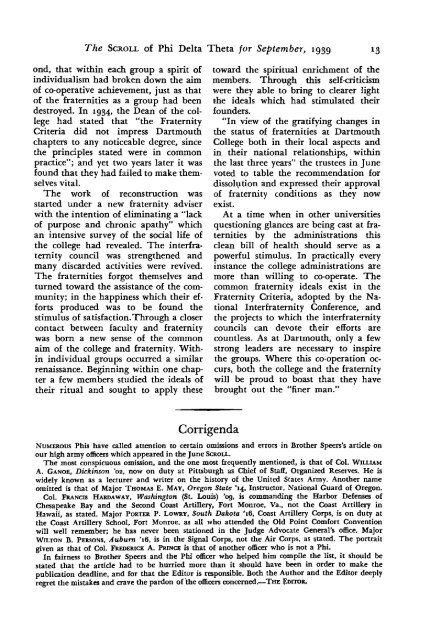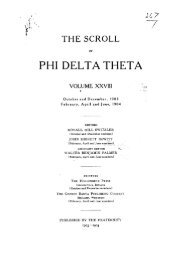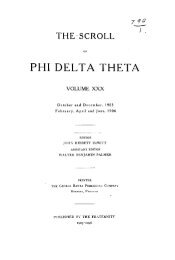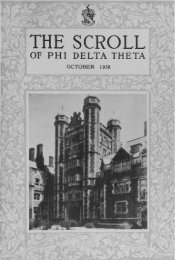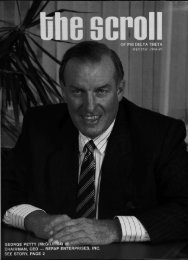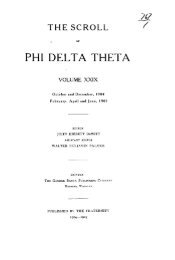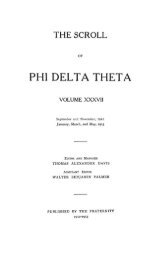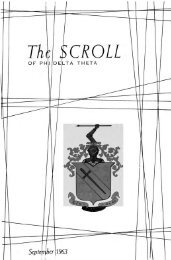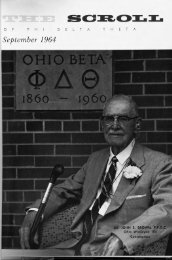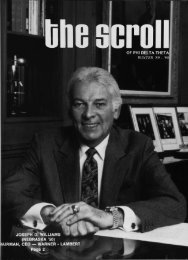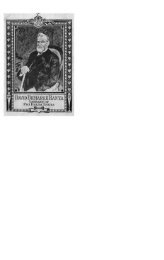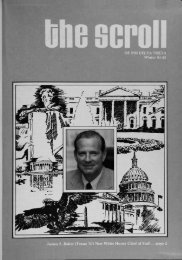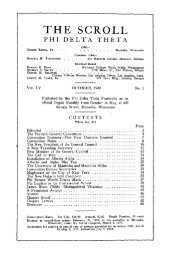- Page 1 and 2: \^m. THE SCROLL OF PHI DELTA THETAi
- Page 3: The SCROLL of Phi Delta Theta Septe
- Page 6 and 7: The SCROLL of Phi Delta Theta for S
- Page 8 and 9: The SCROLL of Phi Delta Theta for S
- Page 10 and 11: New Command for Admiral Cluverius B
- Page 12 and 13: The SCROLL of Phi Delta Theta for S
- Page 16 and 17: Honor Society Elections, 1938-39 ON
- Page 18 and 19: i6 The SCROLL of Phi Delta Theta fo
- Page 20 and 21: i8 The SCROLL of Phi Delta Theta fo
- Page 22 and 23: He Humanizes General Motors INDUSTR
- Page 24 and 25: A New Roving Federal Judge THE conf
- Page 26 and 27: 24 The SCROLL of Phi Delta Theta fo
- Page 28 and 29: 26 T/ie,SCROLL of Phi Delta Theta f
- Page 30 and 31: Phis Make Air Mail History By CLAUD
- Page 32 and 33: A Corner with Phi Authors As viewed
- Page 34 and 35: 32 The SCROLL of Phi Delta Theta fo
- Page 36 and 37: 34 The SCROLL of Phi Delta Theta ja
- Page 38 and 39: 36 The SCROLL of Phi Delta Theta fo
- Page 40 and 41: 38 The SCROLL of Phi Delta Theta jo
- Page 42 and 43: 40 The SCROLL of Phi Delta Theta fo
- Page 44 and 45: 42 The SCROLL of Phi Delta Theta fo
- Page 46 and 47: 44 The SCROLL of Phi Delta Theta fo
- Page 48 and 49: 46 The SCROLL of Phi Delta Theta fo
- Page 50 and 51: 48 The SCROLL of Phi Delta Theta fo
- Page 52 and 53: SNAI'SHOIS Al THE MICHIGAN DIAMOND
- Page 54 and 55: 52 The SCROLL of Phi Delta Theta fo
- Page 56 and 57: 54 T/ze SCROLL of Phi Delta Theta f
- Page 58 and 59: 56 The SCROLL of Phi Delta Theta fo
- Page 60 and 61: 68 The SCROLL of Phi Delta Theta fo
- Page 62 and 63: 6o The SCROLL of Phi Delta Theta fo
- Page 64 and 65:
62 The SCROLL of Phi Delta Theta fo
- Page 66 and 67:
64 The SCROLL of Phi Delta Theta fo
- Page 68 and 69:
66 The SCROLL O£ Phi Delta Theta f
- Page 70 and 71:
68 The SCROLL of Phi Delta Theta fo
- Page 72 and 73:
70 The SCROLL of Phi Delta Theta fo
- Page 74 and 75:
72 The SCROLL of Phi Delta Theta fo
- Page 76 and 77:
PERSONALITIES AT VIRGINIA DELTA'S R
- Page 78 and 79:
76 The SCROLL of Phi Delta Theta fo
- Page 80 and 81:
The Alumni Club Activities DENVER T
- Page 82 and 83:
8o The SCROLL O£ Phi Delta Theta f
- Page 84 and 85:
82 The SCROLL of Phi Delta Theta fo
- Page 86 and 87:
Chapter ^ Grand DAVID CLAY LILLY [C
- Page 88 and 89:
86 The SCROLL of Phi Delta Theta fo
- Page 90 and 91:
88 The SCROLL of Phi Delta Theta fo
- Page 92 and 93:
Director y THE PHI DELTA THETA FRAT
- Page 94 and 95:
92 The SCROLL of Phi Delta Theta fo
- Page 96 and 97:
94 The SCROLL of Phi Delta Theta fo
- Page 98 and 99:
96 The SCROLL of Phi Delta Theta fo
- Page 100:
Surpassing All Previous Displays Is
- Page 103 and 104:
The SCROLL of Phi Delta Theta Novem
- Page 105 and 106:
The SCROLL of Phi Delta Theta Novem
- Page 107 and 108:
The SCROLL of Phi Delta Theta for N
- Page 109 and 110:
The Far-Western Regional By CHARLES
- Page 111 and 112:
The SCROLL of Phi Delta Theta for N
- Page 113 and 114:
The SCROLL of Phi Delta Theta for N
- Page 115 and 116:
The SCROLL of Phi Delta Theta for N
- Page 117 and 118:
Founders Room Custodian By FRANCIS
- Page 119 and 120:
Exit Albania WILLIAM HENRY DANFORTH
- Page 121 and 122:
Ho for Antarctica! By FRANCIS KRAME
- Page 123 and 124:
The SCROLL of Phi Delta Theta for N
- Page 125 and 126:
A New "Phi Delt Bungalow' By J. DOU
- Page 127 and 128:
The SCROLL of Phi Delta Theta for N
- Page 129 and 130:
The Alumni ®E) Firing Line DR. DAV
- Page 131 and 132:
The SCROLL of Phi Delta Theta for N
- Page 133 and 134:
The SCROLL of Phi Delta Theta for N
- Page 135 and 136:
The SCROLL of Phi Delta Theta for N
- Page 137 and 138:
The SCROLL of Phi Delta Theta for N
- Page 139 and 140:
The SCROLL of Phi Delta Theta for N
- Page 141 and 142:
^K) Chapter News in Brief ALABAMA A
- Page 143 and 144:
The SCROLL of Phi Delta Theta for N
- Page 145 and 146:
The SCROLL of Phi Delta Theta for N
- Page 147 and 148:
The SCROLL of Phi Delta Theta for N
- Page 149 and 150:
The SCROLL of Phi Delta Theta for N
- Page 151 and 152:
The SCROLL of Phi Delta Theta for N
- Page 153 and 154:
The SCROLL of Phi Delta Theta for N
- Page 155 and 156:
The SCROLL of Phi Delta Theta for N
- Page 157 and 158:
The SCROLL of Phi Delta Theta for N
- Page 159 and 160:
The SCROLL of Phi Delta Theta for N
- Page 161 and 162:
The SCROLL of Phi Delta Theta for N
- Page 163 and 164:
Chapter ^©1 Grand ± Iq S FERDINAN
- Page 165 and 166:
The SCROLL of Phi Delta Theta for N
- Page 167 and 168:
The SCROLL of Phi Delta Theta for N
- Page 169 and 170:
The SCROLL of Phi Delta Theta for N
- Page 171 and 172:
The SCROLL of Phi Delta Theta for N
- Page 173 and 174:
The SCROLL of Phi Delta Theta for N
- Page 175 and 176:
Do Your Phikeias THE MANUAL Have Th
- Page 178 and 179:
Towards a free mind WHERE lies free
- Page 180 and 181:
TOM HARMON-GOOD SPORTSMAN. GOOD PHI
- Page 182 and 183:
N 1- B I-I < I-I t I-I w H p u O h
- Page 184 and 185:
174 The SCROLL of Phi Delta Theta f
- Page 186 and 187:
176 The SCROLL of Phi Delta Theta f
- Page 188 and 189:
178 The SCROLL of Phi Delta Theta j
- Page 190 and 191:
i8o The SCROLL of Phi Delta Theta f
- Page 192 and 193:
18s The SCROLL of Phi Delta Theta f
- Page 194 and 195:
Minneapolis Convention, 1940 By WAL
- Page 196 and 197:
Phis of the Fighting Navy By LELAND
- Page 198 and 199:
Canadian Phis in High Commands ARMA
- Page 200 and 201:
Robert Rhea Joins the Chapter Grand
- Page 202 and 203:
iga The SCROLL of Phi Delta Theta f
- Page 204 and 205:
The Cruise of the Patsy SAILING und
- Page 206 and 207:
196 The SCROLL of Phi Delta Theta f
- Page 208 and 209:
The Alumni ^El Firing Line ALBERT R
- Page 210 and 211:
800 The SCROLL of Phi Delta Theta f
- Page 212 and 213:
202 The SCROLL of Phi Delta Theta f
- Page 214 and 215:
204 The SCROLL of Phi Delta Theta f
- Page 216 and 217:
2o6 The SCROLL of Phi Delta Theta f
- Page 218 and 219:
208 The SCROLL of Phi Delta Theta f
- Page 220 and 221:
210 The SCROLL of Phi Delta Theta f
- Page 222 and 223:
212 The SCROLL of Phi Delta Theta f
- Page 224 and 225:
214 The SCROLL of Phi Delta Theta f
- Page 226 and 227:
2l6 The SCROLL of Phi Delta Theta f
- Page 228 and 229:
2l8 The SCROLL of Phi Delta Theta f
- Page 230 and 231:
220 The SCROLL of Phi Delta Theta f
- Page 232 and 233:
asa The SCROLL of Phi Delta Theta f
- Page 234 and 235:
224 The SCROLL of Phi Delta Theta f
- Page 236 and 237:
226 The SCROLL of Phi Delta Theta f
- Page 238 and 239:
228 The SCROLL of Phi Delta Theta f
- Page 240 and 241:
Chapter Q Grand DWIGHT EDWIN BAUM,
- Page 242 and 243:
232 The SCROLL of Phi Delta Theta f
- Page 244 and 245:
THE Directory PHI DELTA THETA FRATE
- Page 246 and 247:
236 The SCROLL of Phi Delta Theta f
- Page 248 and 249:
238 The SCROLL of Phi Delta Theta f
- Page 250 and 251:
240 The SCROLL of Phi Delta Theta f
- Page 252 and 253:
Surpassing AU Previous Displays Is
- Page 254 and 255:
^^ «i^ ^ College and Fraternity—
- Page 257:
The SCROLL of Phi Delta Theta March
- Page 260 and 261:
Security, American Style By PAUL \V
- Page 262 and 263:
The SCROLL of Phi Delta Theta for M
- Page 264 and 265:
250 The SCROLL of Phi Delta Theta f
- Page 266 and 267:
258 The SCROLL of Phi Delta Theta f
- Page 268 and 269:
254 The SCROLL of Phi Delta Theta f
- Page 270 and 271:
256 The SCROLL of Phi Delta Theta f
- Page 272 and 273:
258 The SCROLL of Phi Delta Theta f
- Page 274 and 275:
Minnesota Welcomes the Convention B
- Page 276 and 277:
Another New Province President By C
- Page 278 and 279:
264 The SCROLL of Phi Delta Theta f
- Page 280 and 281:
266 The SCROLL of Phi Delta Theta f
- Page 282 and 283:
268 The SCROLL of Phi Delta Theta f
- Page 284 and 285:
The Alumni t©) Firing Line FRANK C
- Page 286 and 287:
272 The SCROLL of Phi Delta Theta f
- Page 288 and 289:
274 The SCROLL of Phi Delta Theta f
- Page 290 and 291:
276 The SCROLL of Phi Delta Theta f
- Page 292 and 293:
278 The SCROLL of Phi Delta Theta f
- Page 294 and 295:
s8o The SCROLL of Phi Delta Theta f
- Page 296 and 297:
282 The SCROLL of Phi Delta Theta f
- Page 298 and 299:
284 The SCROLL of Phi Delta Theta f
- Page 300 and 301:
286 The SCROLL of Phi Delta Theta f
- Page 302 and 303:
288 The SCROLL of Phi Delta Theta f
- Page 304 and 305:
290 The SCROLL of Phi Delta Theta f
- Page 306 and 307:
292 The SCROLL of Phi Delta Theta f
- Page 308 and 309:
294 The SCROLL of Phi Delta Theta f
- Page 310 and 311:
296 The SCROLL of Phi Deha Theta fo
- Page 312 and 313:
298 The SCROLL of Phi Delta Theta f
- Page 314 and 315:
300 The SCROLL of Phi Delta Theta f
- Page 316 and 317:
302 The SCROLL of Phi Delta Theta f
- Page 318 and 319:
304 The SCROLL of Phi Delta Theta f
- Page 320 and 321:
3o6 The SCROLL of Phi Delta Theta f
- Page 322 and 323:
3o8 The SCROLL of Phi Delta Theta f
- Page 324 and 325:
310 The SCROLL of Phi Delta Theta f
- Page 326 and 327:
312 The SCROLL of Phi Delta Theta f
- Page 328 and 329:
Directory THE PHI DELTA THETA FRATE
- Page 330 and 331:
3i6 The SCROLL of Phi Delta Theta f
- Page 332 and 333:
3ic The SCROLL of Phi Delta Theta f
- Page 334 and 335:
320 The SCROLL O£ Phi Delta Theta
- Page 336:
Surptuaing AU Previous Displays is
- Page 339 and 340:
The SCROLL of Phi Delta Theta Publi
- Page 341 and 342:
The SCROLL of Phi Delta Theta Vol.
- Page 343 and 344:
The SCROLL of Phi Delta Theta for M
- Page 345 and 346:
The SCROLL of Phi Delta Theta for M
- Page 347 and 348:
The SCROLL of Phi Delta Theta for M
- Page 349 and 350:
Plans for the Minneapolis Conventio
- Page 351 and 352:
The SCROLL of Phi Delta Theta for M
- Page 353 and 354:
The SCROLL of Phi Delta Theta for M
- Page 355 and 356:
The SCROLL of Phi Delta Theta for M
- Page 357 and 358:
Mississippi Alpha Dedicates Lodge B
- Page 359 and 360:
The SCROLL of Phi Delta Theta for M
- Page 361 and 362:
The SCROLL of Phi Delta Theta for M
- Page 363 and 364:
The SCROLL of Phi Delta Theta for M
- Page 365 and 366:
The SCROLL of Phi Delta Theta for M
- Page 367 and 368:
Whitman Phi Beta Kappas By CAMERON
- Page 369 and 370:
The SCROLL of Phi Delta Theta for M
- Page 371 and 372:
Walter Havighurst's New Novel Revie
- Page 373 and 374:
Texas Delta's Tennis Ace NUMBERED a
- Page 375 and 376:
The SCROLL of Phi Delta Theta for M
- Page 377 and 378:
The SCROLL of Phi Delta Theta for M
- Page 379 and 380:
The Alumni ^j^^ Firing Line CHARLES
- Page 381 and 382:
The SCROLL of Phi Delta Theta for M
- Page 383 and 384:
The SCROLL of Phi Delta Theta for M
- Page 385 and 386:
The SCROLL of Phi Delta Theta for M
- Page 387 and 388:
The SCROLL of Phi Delta Theta for M
- Page 389 and 390:
The^ SCROLL of Phi Delta Theta for
- Page 391 and 392:
The SCROLL of Phi Delta Theta for M
- Page 393 and 394:
The SCROLL of Phi Delta Theta for M
- Page 395 and 396:
The SCROLL of Phi Delta Theta for M
- Page 397 and 398:
The SCROLL of Phi Delta Theta for M
- Page 399 and 400:
Chapter News in Brief %i^ ALABAMA A
- Page 401 and 402:
The SCROLL of Phi Delta Theta for M
- Page 403 and 404:
The SCROLL of Phi Delta Theta for M
- Page 405 and 406:
The SCROLL of Phi Delta Theta for M
- Page 407 and 408:
The SCROLL of Phi Delta Theta for M
- Page 409 and 410:
The SCROLL of Phi Delta Theta for M
- Page 411 and 412:
The SCROLL of Phi Delta Theta for M
- Page 413 and 414:
The SCROLL of Phi Delta Theta for M
- Page 415 and 416:
The SCROLL of Phi Delta Theta for M
- Page 417 and 418:
The SCROLL of Phi Delta Theta for M
- Page 419 and 420:
The SCROLL of Phi Delta Theta for M
- Page 421 and 422:
The SCROLL of Phi Delta Theta for M
- Page 423 and 424:
The SCROLL of Phi Delta Theta for M
- Page 425 and 426:
The SCROLL of Phi Delta Theta for M
- Page 427 and 428:
The SCROLL of Phi Delta Theta for M
- Page 429 and 430:
The SCROLL of Phi Delta Theta for M
- Page 431 and 432:
The SCROLL of Phi Delta Theta for M
- Page 433 and 434:
The ScaioLL of Phi Delta Theta for
- Page 435 and 436:
The SCROLL of Phi Delta Theta for M
- Page 437 and 438:
The SCROLL of Phi Delta Theta for M
- Page 439 and 440:
The SCROLL of Phi Delta Theta Index
- Page 441 and 442:
British Columbia Alpha group, 283 B
- Page 443 and 444:
Where Nature Smiles 300 Miles GO BU


